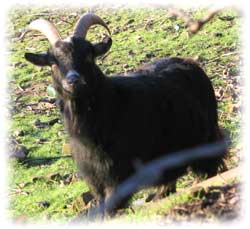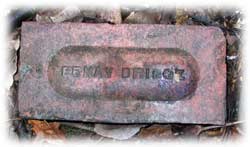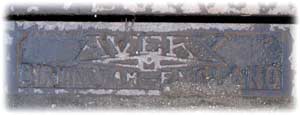Richard Bell's Wild West Yorkshire nature diary
Low Laithes
‹previous
| this month | home
page | e-mail me | next›
Tuesday, 23rd January, 2007

 I
NEED THE CAR today so I take Barbara in to the library. It's just ten minutes
drive from here but in the rush hour it takes longer, making a total of 45 minutes
for the round trip. 45 minutes! I could drive to the Peak District in 45 minutes
and probably use less petrol than I do when the car is in crawling traffic.
I
NEED THE CAR today so I take Barbara in to the library. It's just ten minutes
drive from here but in the rush hour it takes longer, making a total of 45 minutes
for the round trip. 45 minutes! I could drive to the Peak District in 45 minutes
and probably use less petrol than I do when the car is in crawling traffic.
 I
must admit that I did come back the pretty way, via Low Laithes
and, hey, isn't that my artwork on the sign? It's hard to tell at a glance but
years ago I drew them a logo of a barn owl perched on a tee
marker flag. Perhaps they're still be using it. The Low
Laithes Golf Club website includes a map
of the course; hover the mouse over each hole no. to see the view from the
tee.
I
must admit that I did come back the pretty way, via Low Laithes
and, hey, isn't that my artwork on the sign? It's hard to tell at a glance but
years ago I drew them a logo of a barn owl perched on a tee
marker flag. Perhaps they're still be using it. The Low
Laithes Golf Club website includes a map
of the course; hover the mouse over each hole no. to see the view from the
tee.
I wonder if they still have a resident barn owl? The habitat looks perfect.
Goat
 It's
amazing what you see on a walk in the country around here. I didn't expect to
see these wild-looking goats so close to Horbury.
It's
amazing what you see on a walk in the country around here. I didn't expect to
see these wild-looking goats so close to Horbury.
 It's
a fine afternoon so I'm out checking out the last of my walks, an extra one
I've added to the original four. The goats are near Storrs Hill
which was the route I took to and from school during my five years at Ossett
Grammar.
It's
a fine afternoon so I'm out checking out the last of my walks, an extra one
I've added to the original four. The goats are near Storrs Hill
which was the route I took to and from school during my five years at Ossett
Grammar.
Bricks & Coal
 This
brick was lying on a little-used footpath down by the railway.
The name Fenay Bridge has been appearing on housing developer's
signs; an old quarry site has been landscaped on a hillside near Huddersfield.
This
brick was lying on a little-used footpath down by the railway.
The name Fenay Bridge has been appearing on housing developer's
signs; an old quarry site has been landscaped on a hillside near Huddersfield.
The Avery scales (below, right) were used to weigh
lorries filled up with coal from Hartley Bank Colliery. I remember
a walk from St Peter's Junior school one afternoon in the early 1960s. We visited
the colliery (but didn't go underground), watched coal being loaded into barges
on the adjacent canal, saw the small tank engine hauling a few trucks across
the valley and finally saw the trucks being emptied via a chute into coal merchant's
lorries.
 'If
our whole class stood in the back of one of those lorries,' said our teacher,
Mr Lindley, 'We'd hardly tip the scales.'
'If
our whole class stood in the back of one of those lorries,' said our teacher,
Mr Lindley, 'We'd hardly tip the scales.'
I pace out the steel platform; about 20 feet long; which was probably the typical
size for a lorry in those days.
‹previous
| this month | home
page | e-mail me | next›

 I
NEED THE CAR today so I take Barbara in to the library. It's just ten minutes
drive from here but in the rush hour it takes longer, making a total of 45 minutes
for the round trip. 45 minutes! I could drive to the Peak District in 45 minutes
and probably use less petrol than I do when the car is in crawling traffic.
I
NEED THE CAR today so I take Barbara in to the library. It's just ten minutes
drive from here but in the rush hour it takes longer, making a total of 45 minutes
for the round trip. 45 minutes! I could drive to the Peak District in 45 minutes
and probably use less petrol than I do when the car is in crawling traffic. It's
amazing what you see on a walk in the country around here. I didn't expect to
see these wild-looking goats so close to Horbury.
It's
amazing what you see on a walk in the country around here. I didn't expect to
see these wild-looking goats so close to Horbury. It's
a fine afternoon so I'm out checking out the last of my walks, an extra one
I've added to the original four. The goats are near Storrs Hill
which was the route I took to and from school during my five years at Ossett
Grammar.
It's
a fine afternoon so I'm out checking out the last of my walks, an extra one
I've added to the original four. The goats are near Storrs Hill
which was the route I took to and from school during my five years at Ossett
Grammar. This
brick was lying on a little-used footpath down by the railway.
The name Fenay Bridge has been appearing on housing developer's
signs; an old quarry site has been landscaped on a hillside near Huddersfield.
This
brick was lying on a little-used footpath down by the railway.
The name Fenay Bridge has been appearing on housing developer's
signs; an old quarry site has been landscaped on a hillside near Huddersfield. 'If
our whole class stood in the back of one of those lorries,' said our teacher,
Mr Lindley, 'We'd hardly tip the scales.'
'If
our whole class stood in the back of one of those lorries,' said our teacher,
Mr Lindley, 'We'd hardly tip the scales.'